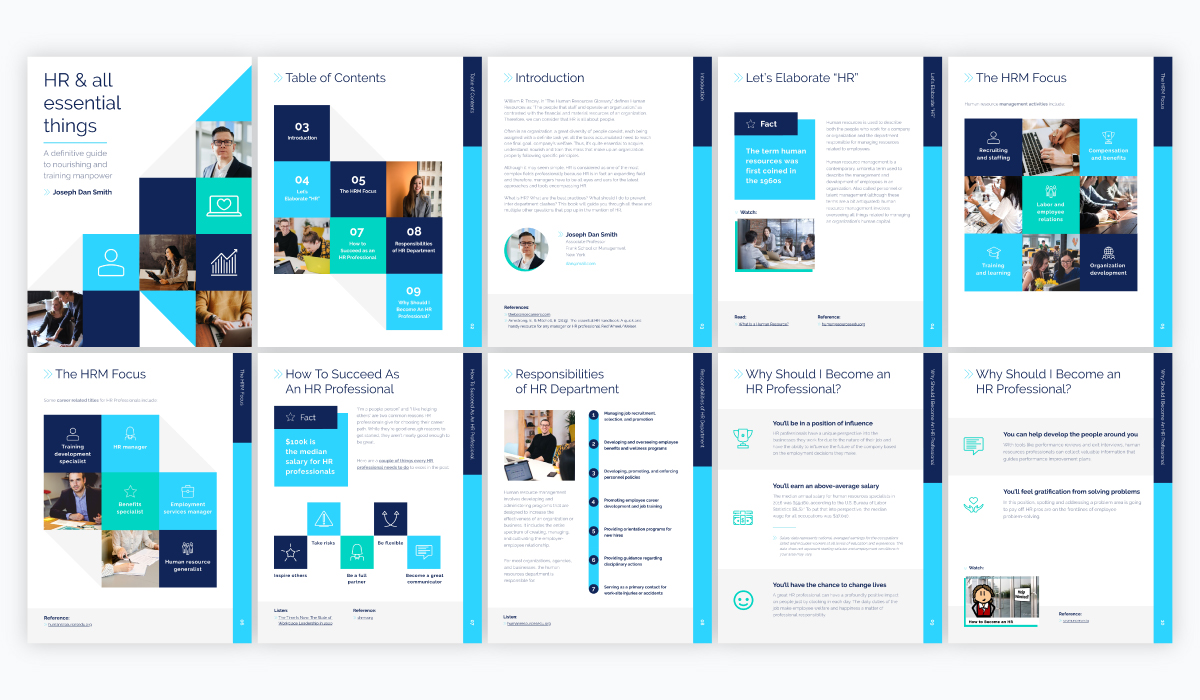Introduction
Welcome to the exciting world of eBook publishing! If you have written an eBook and are ready to share your knowledge or story with the world, one important decision you’ll need to make is how to price your eBook. Determining the right price is crucial for not only attracting readers but also ensuring that you are fairly compensated for your hard work.
When it comes to pricing your eBook, there are several factors to consider. Are you looking to maximize your profits or reach a wider audience? How do you determine the value of your eBook? Is there a specific target audience you have in mind? These are just a few of the questions that we will explore in this guide.
Before diving into the details, it’s essential to understand the importance of conducting thorough market research. By gathering insights into the industry, analyzing similar eBooks’ prices, and evaluating your target audience’s willingness to pay, you can make informed decisions about pricing your eBook.
Additionally, keeping an eye on production costs, setting a competitive price point, and offering special promotions or discounts can help boost your eBook sales. Furthermore, it’s crucial to adjust the price over time based on sales performance and reader feedback to ensure that your eBook remains competitive in the market.
In this guide, we will delve into each of these aspects, providing you with the knowledge and strategies needed to determine the ideal pricing strategy for your eBook. So, let’s get started and unlock the secrets to pricing your eBook effectively!
Researching the Market
Before setting the price for your eBook, it’s essential to conduct thorough market research. Understanding the current trends, demand, and pricing strategies in the market will help you make informed decisions and position your eBook competitively. Here are some key steps to consider:
1. Identify your target audience: Determine the demographic and interests of your potential readers. This will help you tailor your eBook’s content and pricing to meet their needs and preferences.
2. Explore eBook platforms: Research popular eBook platforms such as Amazon Kindle, Barnes & Noble Nook, or Apple Books. Analyze the pricing patterns of similar eBooks in your genre to get a sense of the market standard.
3. Monitor bestseller lists: Pay attention to the bestselling eBooks in your category. Take note of their pricing strategy and assess whether it aligns with the value you offer in your eBook.
4. Seek reader feedback: Engage with your target audience through forums, social media, or email lists. Ask for their opinions on eBook pricing and preferences. This valuable feedback will provide insights into what readers are willing to pay for eBooks like yours.
5. Analyze competitor pricing: Examine the pricing strategies of other authors in your niche. Compare factors such as book length, content quality, and author reputation to determine how your eBook should be priced relative to the competition.
6. Consider customer reviews: Evaluate the feedback and reviews of eBooks similar to yours. Look for comments on pricing and whether readers felt they received value for money. This will give you a better understanding of how to price your eBook appropriately.
7. Follow industry news: Stay up to date with industry news and trends related to eBook pricing. Keep an eye on any changes in consumer behavior, pricing models, or platform policies that could affect your eBook’s pricing strategy.
Taking the time to research the market will provide you with valuable insights and a solid foundation for determining the right price for your eBook. By understanding your target audience and analyzing the competition, you will be well-equipped to make informed decisions that will maximize your eBook’s success.
Determining the Value of Your eBook
When setting the price for your eBook, it’s essential to consider the value it offers to readers. The perceived value plays a significant role in determining how much readers are willing to pay. Here are some factors to help you determine the value of your eBook:
1. Content quality: Assess the quality and uniqueness of your eBook’s content. Does it provide valuable information, insights, or entertainment? High-quality content that meets the needs of your target audience can justify a higher price.
2. Expertise and authority: Consider your expertise or authority in the subject matter of your eBook. If you have extensive experience or credentials, readers may perceive your eBook to be more valuable, which can justify a higher price point.
3. Length and depth: Evaluate the length and depth of your eBook. Longer and more comprehensive eBooks may be perceived as more valuable compared to shorter ones. However, be mindful that readers also value concise and focused content.
4. Uniqueness and innovation: Determine if your eBook offers a unique perspective or innovative ideas. Originality can add value to your eBook and make it stand out from others in the market.
5. Target audience relevance: Consider how well your eBook aligns with the needs and interests of your target audience. A highly relevant and personalized eBook can command a higher price due to its specific value proposition.
6. Supplementary materials: If your eBook includes additional resources such as worksheets, templates, or audio/video content, it can increase its perceived value and justify a higher price.
7. Brand recognition: If you have an established brand or a loyal following, readers may be willing to pay a premium for your eBook based on trust and familiarity with your work.
8. External factors: Consider any external factors that may impact the value of your eBook. For example, if the topic is highly in demand or if there is limited competition, you may be able to price your eBook higher.
By carefully evaluating these factors, you can determine the value that your eBook offers to readers. Remember, pricing your eBook too low may undersell its value, while pricing it too high may deter potential buyers. Striking the right balance will help you attract readers and maximize the returns on your hard work.
Analyzing Similar eBooks’ Prices
An important step in determining the price of your eBook is analyzing the prices of similar eBooks in your genre. By examining the pricing trends and strategies of other authors, you can gain insights into what readers are willing to pay and position your eBook competitively. Here’s how you can analyze similar eBooks’ prices:
1. Identify comparable eBooks: Look for eBooks in your genre that have similar content, target audience, and value proposition. These are the eBooks that you’ll be comparing to in terms of pricing.
2. Take note of the price range: Make a note of the price range within which similar eBooks are priced. Identify the lowest and highest prices and the average price point. This will give you an idea of the pricing spectrum in your niche.
3. Consider factors affecting pricing: Evaluate the factors that may influence the pricing of similar eBooks. These factors may include the author’s reputation, book length, content quality, level of research, and extra features or bonuses included.
4. Assess value for money: Examine the reviews and ratings of these eBooks to understand whether readers believe they received value for money. Look for feedback on content quality, formatting, and overall satisfaction to gauge the perceived value of these eBooks.
5. Compare content and value: Compare the content and value offered by these eBooks against your own. Consider whether your eBook offers more value, covers additional topics, or provides a unique perspective. This will help you determine whether you can price your eBook higher or if it should be priced similarly.
6. Evaluate price elasticity: Take note of any price changes or promotions that these eBooks have undergone. Assess the impact of these pricing strategies on their sales and popularity. This will give you an understanding of price elasticity within your market.
7. Consider your goals: Reflect on your own goals and aspirations as an author. If you’re looking to maximize your eBook’s reach and gain a wider readership, pricing your eBook competitively within the market average may be more beneficial. However, if your intention is to position yourself as a premium author, you may consider pricing at the higher end of the spectrum.
By analyzing the prices of similar eBooks, you can gain valuable insights into the market dynamics and position your eBook strategically. It’s important to strike a balance between pricing competitively and ensuring that you are fairly compensated for your work. Ultimately, your goal is to find a price point that resonates with your target audience and maximizes your eBook’s success.
Considering Production Costs
While determining the price for your eBook, it’s crucial to take into account the production costs involved. Understanding these expenses will help you set a price that covers your investment and ensures a reasonable return on your efforts. Here are some key production costs to consider:
1. Writing and Editing: Take into account the time and effort you spent writing and editing your eBook. If you hired a professional editor, factor in their fees as well. Consider how much you value your time and expertise, as this will influence your pricing strategy.
2. Cover Design and Formatting: If you hired a designer or used software to create a professional cover and format your eBook, include these costs in your calculations. A well-designed cover can significantly impact a reader’s decision to purchase your eBook.
3. Proofreading and Proof Copies: Investing in proofreading services and ordering proof copies can help ensure a polished final product. Take into account any expenses incurred in this process to determine the overall cost.
4. eBook Conversion: If you enlisted the help of a professional to convert your eBook into different formats (e.g., ePub, PDF), include the conversion fees in your production costs. This is especially important if you plan to distribute your eBook through multiple platforms.
5. Marketing and Promotion: Consider the expenses related to marketing and promoting your eBook. This may include advertising, social media campaigns, professional author websites, or hiring a marketing consultant. These costs contribute to building awareness and attracting readers to your eBook.
6. Audio or Illustration Licensing: If your eBook includes licensed audio clips or illustrations, factor in the licensing fees you paid to use that content. Licensing costs can vary depending on the duration of use and the level of exclusivity granted.
7. Distribution and Platform Fees: Some eBook platforms charge fees or take a percentage of each sale. Take into account these fees when determining the price for your eBook. Consider the platform’s reach and the support it offers in exchange for its fees.
8. Other Miscellaneous Expenses: Don’t forget to include any other miscellaneous expenses related to your eBook’s production, such as ISBN registration, copyright fees, or professional author headshots.
By considering these production costs, you can determine a price that covers your expenses and ensures a reasonable profit for your eBook. It’s important to strike a balance between covering your costs and offering a price that your target audience finds attractive. Remember, pricing too high may deter potential buyers, while pricing too low may undervalue your hard work and impact your long-term sustainability as an author.
Evaluating Your Target Audience’s Willingness to Pay
Understanding your target audience’s willingness to pay is crucial in determining the price for your eBook. By evaluating their purchasing behavior, preferences, and budget, you can set a price that resonates with them and encourages conversions. Here are some key points to consider when evaluating your target audience’s willingness to pay:
1. Conduct Surveys or Polls: Engage with your target audience through surveys or polls to gather insights into their spending habits and price sensitivity. Ask questions about their budget for eBooks and what factors influence their purchasing decisions.
2. Analyze Similar eBook Purchases: Examine the purchasing behavior of your target audience when it comes to similar eBooks in your genre. Look for patterns in price ranges and popularity to gauge the price points at which readers are more likely to make a purchase.
3. Consider Disposable Income: Take into account the disposable income of your target audience. If your eBook caters to a niche market with higher income levels, you may be able to price it at a premium. Conversely, if your target audience has limited disposable income, a more affordable price may be necessary.
4. Evaluate eBook Budget Allocation: Assess how your target audience allocates their eBook budget. Do they set aside a specific amount? Do they allocate more funds for genres they are highly interested in? Understanding their budgeting patterns can help you position your eBook’s price accordingly.
5. Consider Perceived Value: Evaluate the perceived value of your eBook in the eyes of your target audience. Does your eBook offer unique insights or solve a specific problem? If your eBook is seen as high-value, your target audience may be willing to pay a higher price.
6. Look for Loyalty: Consider the loyalty and following you have built with your target audience. If you have a strong and loyal fan base, they may be more willing to pay a premium for your eBook based on their trust and appreciation for your work.
7. Assess Market Trends: Stay informed about the market trends and dynamics that impact your target audience’s willingness to pay. Factors such as changes in the industry, economic conditions, or the popularity of eBooks in your genre can influence their purchasing decisions.
8. Test Different Price Points: Consider testing different price points to gauge your target audience’s response. By analyzing sales data and reader feedback, you can fine-tune your pricing strategy and find the sweet spot that maximizes both revenue and reader satisfaction.
Evaluating your target audience’s willingness to pay requires a deep understanding of their preferences, purchasing behavior, and economic capacity. By aligning your eBook’s price with their expectations and budget, you can increase the likelihood of attracting potential readers and maximizing your eBook’s success.
Setting a Competitive Price Point
Setting a competitive price for your eBook is crucial in attracting readers and standing out in a crowded market. A well-considered price can help position your eBook as a valuable and enticing option for potential buyers. Here are some key factors to consider when setting a competitive price point:
1. Analyze Similar eBooks’ Prices: Examine the prices of eBooks in your genre that are comparable to yours. Take note of the pricing range and average price points. This will give you a benchmark to ensure that your eBook is competitively priced within the market.
2. Consider Value for Money: Evaluate the value your eBook provides in relation to its price. Consider factors such as content quality, depth of information, unique insights, and supplementary materials. Ensure that your eBook offers a compelling value proposition to justify the price.
3. Balance Profit and Market Reach: Determine your goals as an author and the balance between profit and market reach that you aim to achieve. Pricing your eBook too high may limit its market reach, while pricing it too low may impact your profitability. Find a balance that aligns with your objectives.
4. Assess Target Audience Expectations: Understand the expectations and budget of your target audience. If your eBook serves a niche audience with a higher willingness to pay, you may be able to price it at a premium. However, if your target audience has a limited budget, consider a more affordable price point.
5. Test Different Price Points: Experiment with different price points to gauge the response from your target audience. Analyze sales data and reader feedback to understand how price adjustments impact the demand for your eBook. This iterative approach will help you find the optimal price point.
6. Consider eBook Length and Formatting: Take into account the length and formatting of your eBook. Longer eBooks or those with complex formatting may warrant a higher price due to the additional effort involved in producing them.
7. Evaluate Author Reputation: Consider your reputation as an author. If you have an established brand or a loyal following, readers may be willing to pay more for your eBook based on their trust and familiarity with your work.
8. Monitor Market Trends: Stay up to date with market trends and dynamics that impact eBook pricing. Keep an eye on changes in consumer behavior, industry developments, and competitor pricing strategies. This information will help you adapt and stay competitive in the market.
Setting a competitive price requires a thoughtful approach that takes into account the value of your eBook, the expectations of your target audience, and the dynamics of the market. By finding the right balance, you can attract readers, generate revenue, and establish your eBook as a compelling option amidst the competition.
Offering Special Promotions or Discounts
One effective strategy to attract more readers and boost sales for your eBook is to offer special promotions or discounts. These limited-time offers can create a sense of urgency and incentivize potential buyers to make a purchase. Here are some key considerations when offering special promotions or discounts:
1. Select the Right Time: Choose strategic times to offer promotions, such as during holidays, major book events, or when you’re launching a new eBook. Take advantage of moments when readers are more likely to be searching for new books or looking for discounted deals.
2. Set Clear Objectives: Define your objectives for the promotion. Whether it’s to increase visibility, maximize sales, or engage new readers, clearly articulate what you hope to achieve so that you can plan the promotion accordingly.
3. Determine the Discount or Promotion Type: Decide on the type of discount or promotion that best aligns with your goals. This could include a percentage discount, limited-time price reduction, bundle offer, or free bonus content with purchase.
4. Create a Sense of Urgency: Emphasize the time-limited nature of the promotion to create a sense of urgency. Use phrases like “limited time offer” or “for a limited number of copies” to motivate readers to take action before the promotion ends.
5. Leverage Email Marketing and Social Media: Utilize your email list and social media platforms to announce and promote your special offer. Craft compelling messages, create eye-catching visuals, and use persuasive language to entice readers to take advantage of the promotion.
6. Collaborate with Influencers: Partner with influencers or fellow authors to spread the word about your promotion. Their endorsement and reach can help expand your audience and attract new readers who may be more likely to purchase during the promotion.
7. Monitor and Track Performance: Keep a close eye on the sales and engagement generated by the promotion. Track the effectiveness of different types of promotions and discounts to fine-tune your strategy for future endeavors.
8. Reward Loyal Readers: Show appreciation for your loyal readers by offering exclusive discounts or promotions to them. This not only strengthens the relationship with your existing audience but also encourages them to spread the word and attract new readers to your eBook.
By offering special promotions or discounts, you can create excitement around your eBook and encourage readers to take action. Leveraging strategic timing, clear objectives, and effective promotion methods can help you maximize the impact of your special offers and ultimately increase sales and reader engagement.
Adjusting the Price Over Time
Adjusting the price of your eBook over time can be a valuable strategy to optimize sales, respond to market dynamics, and maintain competitiveness. As market conditions change and you gather feedback from readers, fine-tuning your pricing strategy can help you maximize profitability and appeal to a broader audience. Here are key considerations when adjusting the price of your eBook:
1. Monitor Sales Performance: Regularly review your eBook’s sales performance to identify trends and patterns. Analyze the impact of price changes on sales volume and revenue. This data will inform your decision-making process when adjusting the price.
2. Stay Informed About Market Trends: Keep a close eye on industry trends and dynamics that can impact eBook pricing. Stay up to date with changes in consumer behavior, competitive pricing strategies, and platform policies. This information will help you adapt your pricing and stay competitive in the market.
3. Collect and Analyze Reader Feedback: Encourage readers to provide feedback on your eBook and its pricing. Monitor reviews, conduct surveys, or engage with readers through social media to gain insights into their perception of your eBook’s value. This feedback can guide you in making price adjustments that align with reader expectations.
4. Consider Seasonality and Demand Fluctuations: Take into account seasonal fluctuations in demand for your eBook or any relevant events that may impact reader interest. Adjusting your price to be more competitive during high-demand periods can help maximize your sales during those times.
5. Evaluate the Competition: Continuously assess the pricing strategies of other eBooks in your genre. Compare factors such as content quality, book length, and reader reviews. Adjust your price to remain competitive and provide comparable value to readers.
6. Use Limited-Time Offers: Introduce limited-time promotions or discounts to generate excitement and spur sales. This strategy not only encourages impulse purchases but also creates a sense of urgency for readers to take advantage of the offer.
7. Bundle and Cross-Promote: Consider bundling your eBook with other related products or collaborating with fellow authors to cross-promote each other’s work. Adjust the price of the bundle or joint offering to provide added value to readers and increase overall sales.
8. Evaluate Pricing Strategy Regularly: Establish a schedule to review and evaluate your pricing strategy on a regular basis. This could be quarterly, semi-annually, or annually, depending on your eBook’s performance and market conditions. Continually refine and adjust your pricing strategy based on data and market feedback.
By adjusting the price of your eBook over time, you can optimize sales, respond to market changes, and better meet the expectations of your target audience. Regular monitoring of sales performance, staying informed about market trends, and actively seeking reader feedback will help you make informed decisions when implementing price adjustments.
Monitoring Sales and Feedback
Continuously monitoring sales and gathering feedback from readers is crucial to the success and longevity of your eBook. By staying informed about its performance and understanding readers’ experiences and preferences, you can make data-driven decisions and improve your eBook over time. Here are key aspects to consider when monitoring sales and feedback:
1. Tracking Sales Performance: Keep a close eye on your eBook’s sales data, including the number of copies sold, sales revenue, and trends over time. Use analytics tools provided by eBook platforms or external software to track and analyze this data effectively.
2. Analyzing Sales Patterns: Identify patterns in your eBook’s sales data. Look for trends based on different factors such as time of year, promotional activities, or changes in pricing. This analysis will help you make informed decisions about adjusting your marketing strategies and pricing.
3. Soliciting Reader Feedback: Actively seek feedback from your readers through various channels such as email, social media, or dedicated forums. Encourage readers to share their thoughts on the content, writing style, and overall experience of reading your eBook.
4. Responding to Reviews and Comments: Engage with readers by responding to their reviews and comments. Acknowledge and appreciate positive feedback, and address any concerns or criticisms constructively. This interaction builds rapport with your readership and shows that you value their opinions.
5. Utilizing Surveys or Polls: Conduct surveys or polls to gather specific insights on reader preferences, expectations, or suggestions for improvement. Craft targeted questions to extract useful data that can guide your future content development and marketing strategies.
6. Identifying Strengths and Weaknesses: Analyze the feedback received to identify the strengths and weaknesses of your eBook. Determine what aspects resonate with readers and what areas might need improvement or further development.
7. Iterative Improvement: Use the feedback and insights gained from sales monitoring and reader interactions to make iterative improvements to your eBook. This could involve enhancing the content, revisiting the cover design, addressing formatting issues, or refining marketing strategies to better meet readers’ needs and expectations.
8. Staying Agile and Adaptable: As you gather sales and feedback data, be ready to adapt and adjust your eBook to address reader preferences and market trends. Continually refine your strategies to ensure your eBook remains relevant and appealing to your target audience.
By actively monitoring sales performance and gathering feedback from readers, you gain valuable insights to fine-tune your eBook and marketing strategies. This iterative approach allows you to provide an improved reading experience and build a loyal reader base that will support and advocate for your eBook.
Conclusion
Setting the right price for your eBook is a crucial decision that can greatly impact its success. By considering factors such as market research, the value of your eBook, production costs, target audience’s willingness to pay, and competition, you can determine a price that strikes the right balance between profitability and reader appeal.
Researching the market allows you to gain insights into pricing trends and understand what readers in your genre are willing to pay. Analyzing similar eBooks’ prices helps you position your eBook competitively and assess its value in comparison. Considering production costs ensures that you cover your investment and achieve a reasonable return for your efforts.
Evaluating your target audience’s willingness to pay helps you align your pricing with their expectations and budget. Setting a competitive price point requires finding the right balance between profitability and market reach. Offering special promotions or discounts can attract more readers, create a sense of urgency, and boost sales.
Adjusting the price over time enables you to respond to market dynamics, maintain competitiveness, and optimize sales. Monitoring sales performance and gathering feedback from readers provide valuable insights for fine-tuning your eBook and marketing strategies.
In conclusion, remember that pricing your eBook is not a one-time decision but an ongoing process. Regularly assess market trends, evaluate sales performance, and engage with readers to make informed decisions about adjusting your pricing strategy. By finding the right price and continually refining it based on data and feedback, you can maximize your eBook’s success and reach a wider audience of eager readers.

























